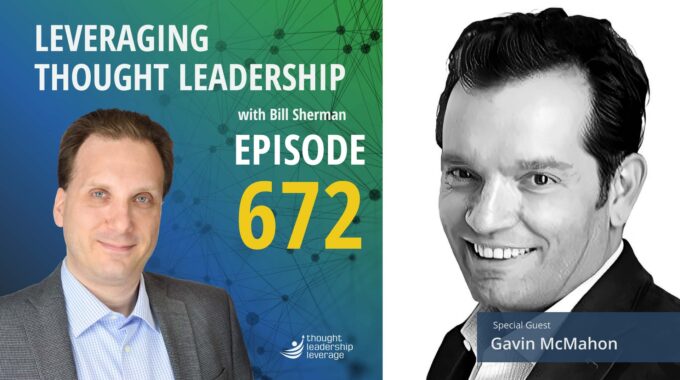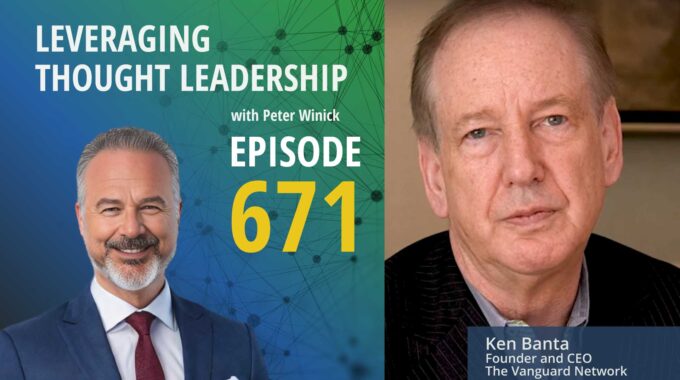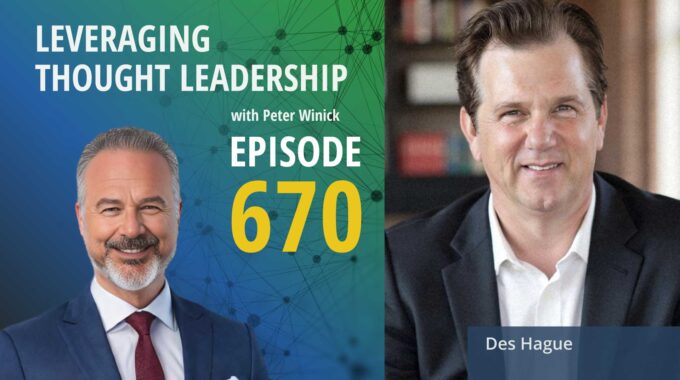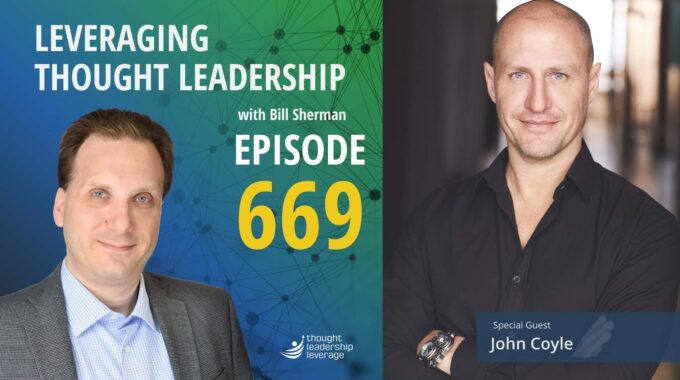How Storytelling Turns Smart Thinking into Real Influence Great ideas don’t win — great stories…
Turning Frameworks into Funding: The Hard Truth About Scaling Thought Leadership | Lisa Kay Solomon
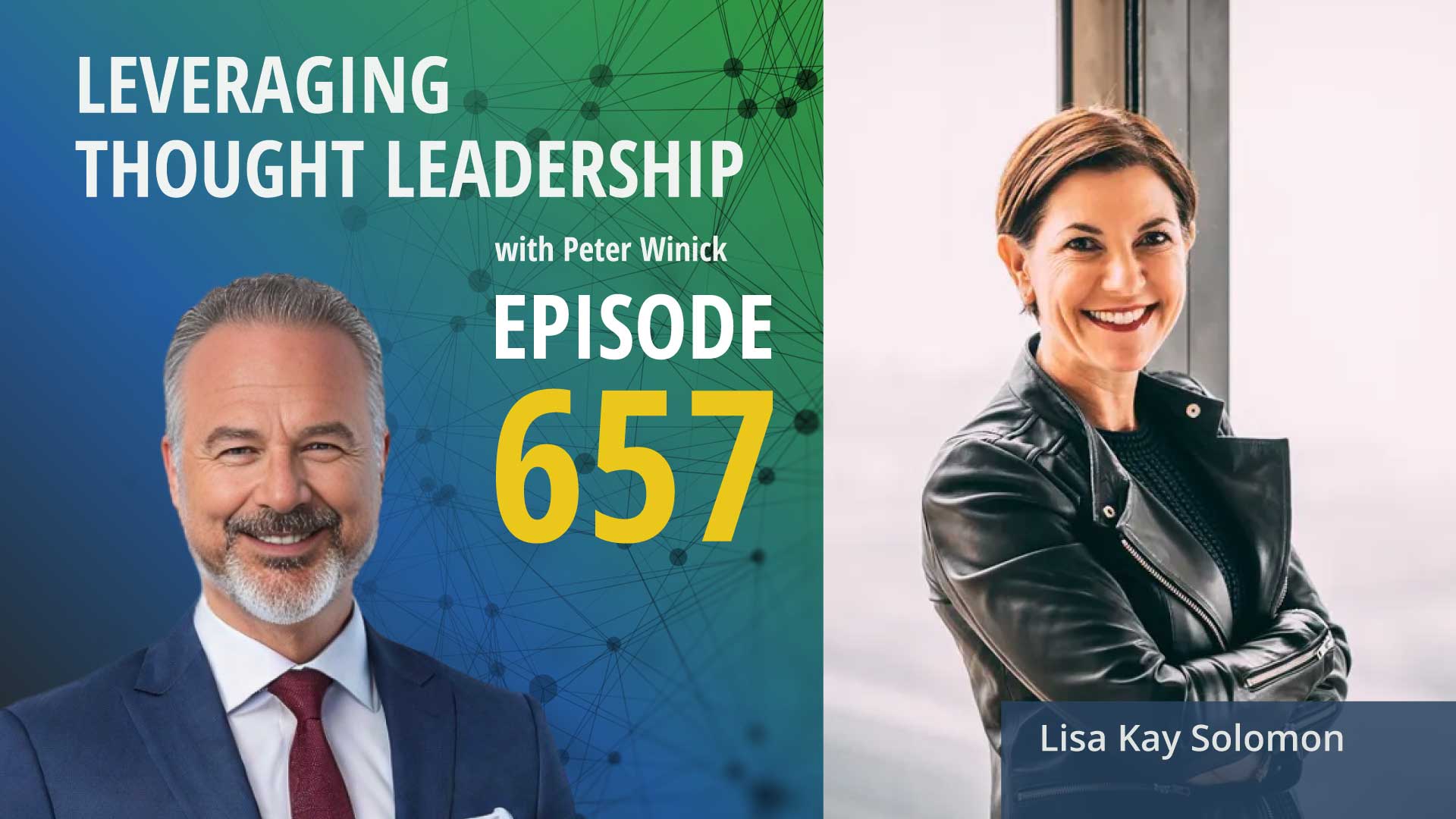
How design thinking and futures literacy can transform your leadership
This episode explores how leaders can use design thinking and futures literacy to navigate complexity, spark innovation, and make better long-term decisions in an uncertain world.
What if you could design the future — instead of reacting to it?
In today’s episode of Leveraging Thought Leadership, Peter Winick sits down with futurist and design strategist Lisa Kay Solomon to explore how leaders can use design thinking to actively shape what’s next.
Lisa is a Designer-in-Residence at Stanford’s d.school, an educator, a bestselling author, and a respected voice on the Thinkers50 Radar list. She helps leaders and organizations make better long-term decisions in a short-term world. Her superpower? Turning vague uncertainty into actionable insight — by teaching leaders how to think like futurists.
Lisa shares how she guides boards, conference planners, and executive teams through complex challenges. She doesn’t just create better experiences — she builds capabilities that last. Whether it’s designing strategic conversations or preparing teams to operate in ambiguity, Lisa brings a toolkit of creative, repeatable practices to move from stuck to strategic.
If you’ve ever found yourself saying, “Yeah, but that would never happen here,” Lisa has a chapter and a strategy just for you.
This conversation is packed with high-impact takeaways for those who want to lead with intention and design a future worth inhabiting.
Three Key Takeaways
Designing the Future Is a Teachable Skill—Lisa argues that futures thinking isn’t a mysterious talent—it’s a learnable capability. Most leaders have been trained to focus on short-term goals. Lisa teaches them how to widen their lens, shift perspective, and think long-term using strategic design practices.
Great Ideas Need More Than Strategy—They Need Capability Organizations often bring Lisa in to spark innovation—whether at board meetings or large conferences. But the real value she delivers goes beyond a single event. She helps teams build the capabilities to sustain innovation, adapt to change, and continue asking the right questions long after she’s gone.
Overcoming the “Yeah, Buts” That Block Progress— Lisa names the top three “yeah, buts” that sabotage future thinking: short-term pressure, lack of resources, and not knowing how. Her approach disarms these mental blockers by reframing possibility as practical—and showing leaders how to move from reactive to proactive in shaping what’s next.
If you found Lisa Kay Solomon’s insights on designing the future and building long-term leadership capabilities compelling, you won’t want to miss our episode with Joseph Press: Thought Leadership for Future Thinking. Both Lisa and Joseph explore how leaders can move beyond short-term fixes to shape more intentional, future-ready organizations. While Lisa focuses on strategic conversations and capability building through design, Joseph dives into how thought
leadership and digital transformation intersect to foster future thinking. Together, these episodes offer a powerful one-two punch for anyone looking to lead with clarity, creativity, and courage in uncertain times. Listen to both and equip yourself with the mindset and tools to not just predict the future—but actively shape it.
Transcript
Peter Winick And welcome, welcome, Welcome. This is Peter Winick. I’m the founder and CEO at thought leadership leverage. And you’re joining me on the podcast today. Today’s guest is Lisa Kay Solomon. And the quote underneath her bio, which I love, is “the future doesn’t have to be something that happens to us.” So Lisa is a designer resident at the Sanford D school. She is a author of several books, co-author of a couple of books. And she’s on the Thinkers 50 radar list or has been on the thinkers 50 radars list. So let’s just hit it. How are you doing today, Lisa?
Lisa Kay Solomon Oh, I’m great, Peter. Thank you so much for having me. Really excited for this conversation. Yeah.
Peter Winick No, no, no. Me too. So how did, how did this happen? How did you get here? Like, cause this is a non-traditional, non-linear, non-predictable place. Like how does, is this what little Lisa dreamed of?
Lisa Kay Solomon Oh my gosh, no kidding, it’s non-traditional. And I will say, Peter, I do wake up these days in spite of how challenging the world feels. I wake up every day grateful to be doing what I’m doing. How to be able to have conversations with people like you, to be working with students at Stanford, at the D school, to help them envision wider futures, futures they want to be a part of and build the skills required to bring those futures to life. It is an accidental career, no doubt. No doubt, but it is one that I was really lucky to design for myself following my own curiosity about why things in the world seemed to work and what was behind those things that worked and to understand that behind a lot of what I found to be interesting or magical or awe-inspirement was this incredible discipline of design.
Peter Winick If I were to say, what was the original plan of I was going to be a X and I wound up a Y and what were the forks in the road?
Lisa Kay Solomon Yeah, well, it depends how far back in the way back machine you go. You know, but honest to goodness, and I have thought about this a bit. When I was younger, you know, middle school age, maybe even younger, I wanted to be president of Walt Disney World. Not like a princess, but like president. And the reason why I wanted to be President of Walt Disney World and why that captured my imagination was because I was lucky to go there as an early kid and found that all, you know, the happiest place on earth. And I remember thinking, like, how do all of these things add up, right, that didn’t just happen, that magic didn’t just happen? How was it that you could go visit a place and it could transport you into a totally different feeling, a totally different sense of wonderment? And that was really what I wanted to be when I was younger. Hey, stay there a minute, because if you talk too…
Peter Winick And say people in the theater, they tell you about the first time they saw a Broadway play or whatever it was. And it was magical. And I wanted to be in the theater. Not I wanted a run the theater. So, all right. So, so that’s a dude, you know, so I’ve, I’ve heard lots of folks say, oh, and then the first I saw a movie, I wanted it to be an actress or writing film or direct or whatever. Right. But like, boom, like I wouldn’t, I want to run the show here. Yeah. I’m like, because I would argue most eight year olds or whatever, tenure, 12 year olds don’t even realize there is that like.
Lisa Kay Solomon I know. I know, I agree. And I think, let me just connect one more dot, which didn’t make sense going forward, but kind of makes sense going backwards. My grandfather was in the restaurant business. So the big thread in my early life was being infatuated with what made for great restaurant experiences. I mean, I literally, Peter, I’m such a nerd. I would get architecture books of restaurants. I was like 12. You know, trying to understand like, wow, that’s so cool that they’re taking this approach and that approach. And we would now call that not just architecture, but experience design. Didn’t have a language for that at the time, but.
Peter Winick And most old would be, it’s cool, grandpa runs a restaurant, I get all the chocolate cake or whatever I want.
Lisa Kay Solomon Right, right? Popovers, chocolate, you know, I ended up going to Cornell, but I didn’t actually go to the hospitality school, which I think was a miss, but I was found myself there. We call them hotelies. I should have been motelly. But I was really just enamored with the experience of day-to-day life and those moments that just felt so wonderful and magical and really did find my way. To exploring the fields of what we now call experience design, organizational design, cultural design. And over the course of my career, realized that the same process and skills that allow designers and inventors to create magical things in our lives, whether they’re products or services, are the same kinds of things that leaders need in order to create new ideas that will help bring us to better futures. So we could talk more about that, That’s the thread. You know, the thread is like, how do we have more agency to make choices that create value for others?
Peter Winick So what does the portfolio of Lisa look like from the standpoint of obviously there’s teaching, there’s writing, there’s research, but who’s engaging with you other than students? And let me put it this way, who’s paying you to get what done then on the non-academic side?
Lisa Kay Solomon Yeah, it’s a great question. I think there are a lot of different people that are, well, that are paying me to get things done, but then there’s the stuff that they don’t yet know they need that they need to be paying me to get stuff done. And at the core, I think it’s like, help us navigate this rapidly changing world that feels like it’s happening at a velocity that we just haven’t experienced before.
Peter Winick And, uh, they didn’t put out an RFP for that. Speaking about what you do is if the toilet’s running, I know, okay, that’s a plumber problem, right? So what are the things that they’re looking at and going, something’s off here, number one and number two. Oh, and Lisa’s the gal that can fix that. Like, how do you think those guys.
Lisa Kay Solomon Yeah, I mean, you know, and it will depend on the audiences. I am lucky enough to be affiliated with the d.school, so, you, know, there’s a lot of excitement around design thinking and what that can offer. So some people find me that way. Some people find that I’ve got a LinkedIn course called Leader as Futurist, so they find me that way, they’re curious, what does that mean to be a futurist? And some folks find me because they know that I have written a lot about how to make decisions amid complexity and ambiguity. You know, 10 years ago, I wrote a book, with my co-author, Chris Urtel, about the practice of designing strategic conversations. And what that means is like, how do you bring people together that have to have conversations about the future and about the feature that involves challenges that are both high stakes and highly important? So for many that could be board meetings. I get a lot of calls and say, Lisa, we’ve got an important board meeting coming up. How do we design it to make sure that we’re really looking at the future in a new way or conferences. Lisa, we’re gathering hundreds of people together have a conversation about the future. We don’t want it to be talking heads on stage. How do you infuse energy and ask the right question and make sure that we’re highlighting the right perspectives in the right way and we’re making it experiential? So I get a lot of those phone calls. What they’re looking for are new ideas. What they also get with me though are new capabilities. This idea that not only are we thinking about the new possibilities, but we’re also improving our own ability to be more resilient and generative in the process.
Peter Winick If you’re enjoying this episode of Leveraging Thought Leadership, please make sure to subscribe. If you’d like to help spread the word about our podcast, please leave a five-star review at ratethispodcast.com forward slash LTL and share it with your friends. We’re available on Apple Podcasts and on all major listening apps as well as at thoughtleadershipleverage.com forward slash podcast.
Peter Winick You said a lot that was interesting to me there, but one piece I want, I want to push on or learn more about is, you know, they’re looking for an outcome, right? So if I hire you to design my conference, what I’m thinking I want is a better conference, right, a good experience. And that would be reflected by attendance, the feedback score, you know like whatever, whatever. I wasn’t, I didn’t ask you to develop a capability, right. So it’s sort of a, an accidental outcome. No, I’m probably thrilled that I got that. Say more about that. Well, it’s not ex-
Lisa Kay Solomon to me because that’s what I want, right? I don’t want transformation, but people don’t say, Lisa, can you get me some of that transformation? They don’t see that, right, they say, I’m feeling this acute pain or I’m feeling like we are stuck or that we need to rethink how we’re going about things, but we’ve never been taught. Can you help us, can help us come up with a process? Can you helped us get to, when we leave here, we want new ideas. We want things that we could fund, we want things we could start. Great, all that’s great. But we know that those great ideas that they wanna start will fall flat if they don’t also have a window into understanding, well, how do they keep them going, right? How do they continue to fuel that? And I’ll say it even more succinct, Peter, this is one of my favorite chapters in the book, Moments of Impact, at the end of teaching the process of how to design strategic conversations. We have a chapter called Overcoming the Yeah Buts, as in, yeah, but that would never happen here. Right, right, right. Like, yeah. Like, great, Lisa. Fun session, but would never happened here. First of all, I often think like, who’s the they in this? Like, they will never let, like, aren’t you the they? Right, so that’s a big headline for me. Like, you are the they. I could sort of, that could be my next. But the Yeah, Buts come in three flavors, and I think all of your listeners can really identify it with this. The first is that, yeah, but we got to focus on near term results, right? Yeah, like, yeah. That long-term thinking is important, but we have quarterly plans. We have an annual plan. We have a strategic plan. This is, we’ve got ARs, KPIs, right. All of our incentive systems are near term focus. The second yeah, but is yeah, but I don’t have the budget. I don’t have the team. I don’t’ have a this, I don’t have a that, right, and we would call that like internal politics. Somebody has it, right You don’t have it, somebody has it.
Peter Winick I forget it.
Lisa Kay Solomon And the third, yeah bud, is like, I don’t know how to do this, I’ve never been taught. And that’s the thing that really drives me, going back to the capability gap, right? And I believe that you can learn to take a longer term, futures length. You can go from near-termism to having a future orientation. You can…
Peter Winick But that’s like, I would say, yeah, but right, but that’s not something most of us picked up along the way, right? If I was to study to be an accountant, an attorney of this or that, that wasn’t on the list of, you know, oh, there’s a critical thinking class, or there’s tort law class or whatever, right, there isn’t a class that says how to be a long term thinker, right.
Lisa Kay Solomon That’s what I do every day, Peter. Okay, let me give you another thought experiment that I do with my students and leaders. I will often start a session, particularly with, I know there’s a lot of skeptics in the group, like, what’s this future stuff? I’ll say, how many people here have taken a class in history? Every hand, right? Taken a class, master’s teaching. I say, great. How many people have taken class in futures?
Peter Winick Great, zero.
Lisa Kay Solomon Then I say, which one of those can you influence?
Peter Winick And where are you going to spend most of your time?
Lisa Kay Solomon And so I really do come to it with great empathy. It’s not our fault that we don’t know how to think about the futures in a disciplined, both creative and critical thinking approach. We’ve never been taught. It’s a thing, but it is a thing. And so my job is to invite more people, make these practices more accessible so that people understand that they are teachable and learnable, just like learning how to tell a great story is teachable and learn able, just like how to build a PowerPoint. Is teachable and learnable. Or a spreadsheet. I wasn’t born knowing how to like build a discounted cash flow. Maybe you were, I wasn’t. But when I help leaders say, look, we can go for them known to the unknown. Here’s one way to do it, right? Let’s use a futures implication wheel and just ask ourselves a series of questions of what if, what if what if. Let’s do a rapid fire scenario planning so we can bring the future to life in tangible ways that provoke better questions today. Let’s go look at the 10,000 year clock that the Long Now Foundation is building about the kind of stewardship that they’re trying to foster. How might that influence that? All of a sudden, you’re changing the dynamic. All you gotta do is open up that wedge. That’s sort of like, oh, I used to see it in black and white. Now I see it and technicolor. Now I understand that the strategic plan that I’ve been operating around is actually a social invention. Somebody created that. It’s actually not serving me well because. The future doesn’t care about your three-year plan? Oh, okay, now I could be more adaptive, but you have to get the right video to open that up.
Peter Winick So let me ask you the final sort of two questions here. As a thought leader, right? What is the easiest or most fun part of what you do and what’s the most difficult?
Lisa Kay Solomon The easiest and fun part is I love what I do and I learn something every day.
Peter Winick I can come across because you’re low energy and low energy
Lisa Kay Solomon Yeah, yeah.
Peter Winick The energy of an actuary that hates being an act…
Lisa Kay Solomon If only something interested me. Right now, Peter, I’m teaching a class called View From the Future at the d.school. Every week we bring in an industry pioneer on the edge of their field, exploring what’s next. I get to have conversations with these incredible leaders that are architecting the future of food. Yesterday we did the future media. Next week we’re doing the future architecture. That is so fun. And my job is to tee up the conversation. And help connect dots for our students so that they’re changing their own thinking. What a blast, what a blast. I love that. I see opportunity everywhere.
Peter Winick And the heart.
Lisa Kay Solomon The hard part is, is that it’s really hard to communicate it quickly. People are busy, our attention spans are shrinking. Probably most importantly, our amygdalas and our nervous systems are wired for threat and fear, and in order to try to invite them to have a generative and abundant conversation about the future, I have to work against both the biological system that we are endowed with. And the context that we are in right now, which is serving up more fear than possibility.
Peter Winick Love it. Thank you so much for that. There’s a lot here. This has been a blast. So, thanks for coming on and thanks for sharing your story with us. I appreciate it. Thanks, Lisa. Thank you. Thanks for what you do.
Peter Winick To learn more about Thought Leadership Leverage, please visit our website at ThoughtLeadershipLeverage.com. To reach me directly, feel free to email me at peter at Thought Leadership leverage.com and please subscribe to Leveraging Thought Leadership on iTunes or your favorite podcast app to get your weekly episode automatically.


